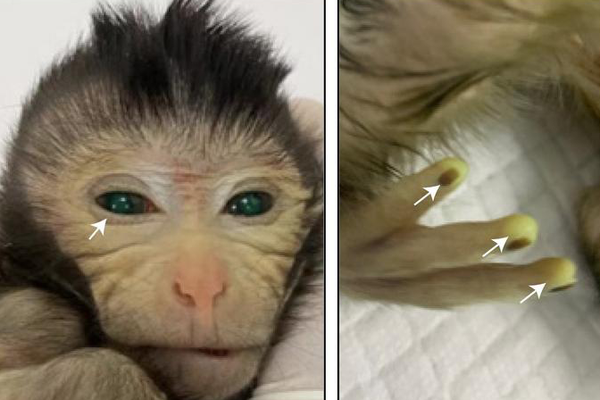November 10, 2023
Thank you for reading this post, don't forget to subscribe!3 min read
Researchers created a monkey that combines cells from two different individuals; a lab technique gave it a strange green glow

Images show green fluorescence signals in different body parts of a live-birth chimeric monkey at the age of three days.
Scientists have just achieved a milestone in stem-cell biology after creating a monkey from two embryos. And proof of the achievement, perhaps unnervingly, showed up in the infant primate’s eerie green glow.
Although research labs have created such “chimeras,” or organisms with cells from two distinct sources, in rats and mice, monkeys have been more challenging to work with because of their increased biological complexity and longer gestation and maturation time. In previous attempts, scientists have struggled to successfully incorporate injected stem cells into a monkey, with less than 5 percent of the final organism grown from donor cells. In the new work, published November 9 in Cell, researchers managed to create a monkey that had an average of more than 60 percent donor cell expression across tested organs.
Scientists hope that someday such chimeras could model human diseases: if inserted stem cells carry genomes associated with a specific condition, researchers can then study how they behave in an organism. Such applications are still distant, however, according to Jun Wu, a stem-cell biologist at the University of Texas Southwestern Medical Center who was not involved in the new research and believes the work is most valuable as a basic science finding.
The high contribution from the donor stem cells the research achieved is what gave the infant cynomolgus monkey (Macaca fascicularis) a strange green tinge. Before the stem cells were injected into the host embryo, scientists edited the cells to express green fluorescent protein, which was originally found in a jellyfish and glows green under blue light. The modification allows scientists to evaluate just how much of a developing embryo came from the stem cells they added. “It’s good for tracking the cells so you can distinguish the cells that you injected in the embryo from the embryonic cells,” Wu says.
Although the greenish glow is evident in released images of the monkey the researchers created, it isn’t so green as to suggest that 60 percent of the monkey’s cells came from donor material. That’s not surprising, Wu says, noting that scientists use specific assays to calculate levels of the protein in the cells and organisms they work with. “It’s difficult from just the images to get a sense of how much the cells are contributing,” he says.
Uptake levels of donor material varied widely between the baby monkey’s organs, with particularly high levels in the brain, heart, kidney and lung, among other locations. Scientists do know a few factors that influence how well stem cells are incorporated into organs. Pluripotent stem cells, which can become any cell of the body, come in different varieties. These include naive cells, which act like cells from a preimplantation embryo and are more readily incorporated, and primed pluripotent stem cells, which act like postimplantation cells and can’t be incorporated into chimeras at all. And the materials that cells and embryos are kept in over the course of the experiment can also affect incorporation, Wu says, although biologists are still working to understand other factors at play.
Wu says that for him, the key value of the study comes in proving out the high pluripotency of the stem cells that scientists use in the lab. Still, he’s worried by the fact that the researchers were able to coax forth only one baby monkey able to produce the green fluorescent protein out of 74 embryos, and the monkey had to be euthanized at just 10 days old because of breathing problems. To really feel confident in the technique, he’d want to see it result in healthy, adult monkeys that can pass cells derived from the donor material onto their own offspring.
“It would be valuable to follow up on this work to further improve this technology to make sure that the chimeric monkeys can grow to adulthood and produce offspring that have cells coming from the donor,” Wu says. At that point, researchers may be able to use this technique to develop models that ultimately help tackle human diseases, he hopes.

